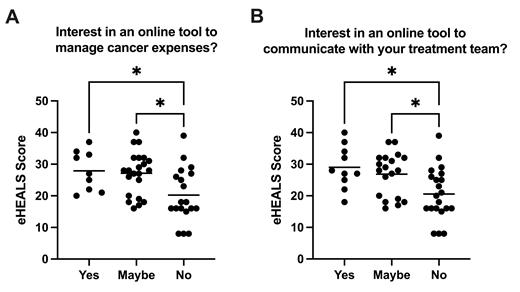Introduction: Financial toxicity is the harmful effect of treatment costs on a patient's quality of life. Financial toxicity is common among cancer patients, and patients with hematologic malignancies often report worse financial toxicity than patients with other cancers. Thus, interventions to address financial toxicity in patients with hematologic cancers are urgently needed. Promising approaches include the use of digital media such as websites and educational videos. However, digital interventions may not be accessible for patients with low digital health literacy (DHL; the capacity to find and understand health-related information using electronic media). Information about DHL in patients with blood cancers is needed to inform future interventions addressing financial toxicity and other quality-of-life related issues. Here, we present a mixed-methods study describing DHL and its correlates among patients with non-Hodgkin lymphoma (NHL) who participated in a larger study about financial toxicity.
Methods: Patients who received systemic therapy for NHL within the last year (N=50) participated in a cross-sectional study about the financial impact of cancer. Participants self-reported financial toxicity (Comprehensive Score for Financial Toxicity; COST) and digital health literacy (electronic Health Literacy Scale; eHEALS). They also rated whether they would consider using online tools to manage cancer-related expenses or communicate with their team about financial concerns, if offered in the future (yes, maybe, no). A subset of survey participants (n=13) completed a follow-up qualitative interview. Survey participants were purposively selected for interviews based on self-reported financial toxicity. Independent-samples t-tests, ANOVA, and correlations were used to test relationships between financial toxicity, DHL, sociodemographic factors, and patient preferences for intervention modalities/approaches. Rapid qualitative analysis was used to summarize participants' suggested modalities for financial toxicity interventions.
Results: In this convenience sample of participants with NHL, participants were primarily older adults (median age 66, IQR 58-72.5), male (62%), and white/Caucasian (80%), with some college or more education completed (76%). The mean COST score was 28.0 (SD= 11.6, range: 0-44), with 32% reporting significant financial toxicity (COST score < 17.5). The mean eHEALS score was 24.6 (SD= 8.10, range: 8-40), and DHL did not vary significantly by age, gender, race/ethnicity, or household income (all p-values > 0.05). There was not a statistically-significant association between financial toxicity and DHL (r=0.028, p=0.849). However, DHL varied according to participants' preferences for online tools (Figure 1). Those who were interested in using online tools to manage cancer-related expenses reported higher DHL than those who were not interested(F(2,47)=5.43, p=0.007); there was a similar pattern for those interested in an online tool to communicate with their care teams (F(2,47)=5.73, p=0.006). Qualitative interviews (n=13) provided additional context for preferred formats for financial toxicity intervention preferences. For example, when asked about the best format for financial toxicity interventions, participants with higher levels of DHL suggested websites and phone applications, whereas participants with lower DHL levels suggested non-electronic modalities. Comfort level and barriers for utilizing technology-based interventions were also explored.
Conclusions: A subset of NHL patients experiences financial toxicity, which does not appear to be directly related to DHL. Because DHL varies among patients with NHL, it may be important to risk stratify populations by DHL to appropriately focus and design tools for addressing financial toxicity. Patients with lower DHL may prefer other intervention modalities (e.g., written materials) and/or may benefit from additional support to access digital media interventions. Inclusion of participants with lower DHL levels in the early stages of intervention development may help to ensure that the most appropriate and usable tools for supporting patients with NHL are developed. Additional research is needed to better understand influences and correlates of DHL in patients with hematologic malignancies as well as the best approaches to financial toxicity interventions.
Disclosures
Conley:Pfizer: Research Funding. Derry-Vick:Dechra Pharmaceuticals: Other: Immediate family member employment.


This feature is available to Subscribers Only
Sign In or Create an Account Close Modal